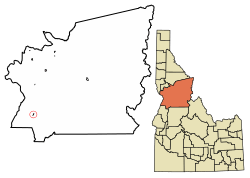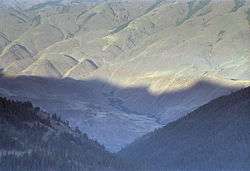Riggins, Idaho
Riggins is a city in Idaho County, Idaho, United States. It is nestled deep in a canyon at the confluence of the Salmon River and the Little Salmon River in west central Idaho, approximately 150 highway miles (240 km) north of Boise, and 120 highway miles (190 km) south-southeast of Lewiston. The elevation of Riggins is 1,821 feet (555 m) above sea level, and the population was 419 at the 2010 census.
Riggins, Idaho | |
|---|---|
| Motto(s): "Idaho's Whitewater Capital"[1] | |
 Location of Riggins in Idaho County, Idaho. | |
| Coordinates: 45°25′20″N 116°18′57″W | |
| Country | United States |
| State | Idaho |
| County | Idaho |
| Area | |
| • Total | 0.45 sq mi (1.15 km2) |
| • Land | 0.40 sq mi (1.03 km2) |
| • Water | 0.05 sq mi (0.12 km2) |
| Elevation | 1,821 ft (555 m) |
| Population | |
| • Total | 419 |
| • Estimate (2019)[4] | 416 |
| • Density | 1,045.23/sq mi (403.92/km2) |
| Time zone | UTC-7 (Mountain) |
| • Summer (DST) | UTC-6 (Mountain) |
| ZIP code | 83549 |
| Area code(s) | 208 |
| FIPS code | 16-67870 |
| GNIS feature ID | 0389360 |
| Website | www |
U.S. Route 95, the only highway for the state connecting the Panhandle to the south, runs through Riggins as Main Street. Along this route, Riggins is the northwesternmost town in the Mountain time zone; the Pacific time begins just north of the city, across the Salmon River.[5][6]
History
Riggins was named for Richard L. Riggins, local businessman and postmaster,[7] and for his father, Fred Riggins, who carried the mail to the area for years.
A sawmill was formerly operated in Riggins, until an explosion and fire in 1982.[8][9]
Geography
Riggins is located at 45°25′20″N 116°18′57″W (45.422125, -116.315848).[10]
According to the United States Census Bureau, the city has a total area of 0.45 square miles (1.17 km2), of which, 0.43 square miles (1.11 km2) is land and 0.02 square miles (0.05 km2) is water.[11]
Climate
According to the Köppen climate classification system, Riggins qualifies as having a humid subtropical climate (Köppen Cfa), a climate type quite untypical for the region. However, due to cold winter months, Riggins's climate nearly qualifies as a dry, hot summer humid continental climate (Köppen Dsa).
| Climate data for Riggins (1896-2012) | |||||||||||||
|---|---|---|---|---|---|---|---|---|---|---|---|---|---|
| Month | Jan | Feb | Mar | Apr | May | Jun | Jul | Aug | Sep | Oct | Nov | Dec | Year |
| Record high °F (°C) | 64 (18) |
72 (22) |
83 (28) |
95 (35) |
103 (39) |
108 (42) |
113 (45) |
115 (46) |
110 (43) |
95 (35) |
80 (27) |
69 (21) |
115 (46) |
| Average high °F (°C) | 41.8 (5.4) |
48.9 (9.4) |
56.5 (13.6) |
65.3 (18.5) |
73.4 (23.0) |
80.8 (27.1) |
92.2 (33.4) |
91.7 (33.2) |
80.9 (27.2) |
66.9 (19.4) |
51.2 (10.7) |
42.5 (5.8) |
66 (19) |
| Average low °F (°C) | 27.8 (−2.3) |
30.6 (−0.8) |
34.2 (1.2) |
39.1 (3.9) |
45.3 (7.4) |
51.5 (10.8) |
57.5 (14.2) |
56.9 (13.8) |
49.6 (9.8) |
41.1 (5.1) |
34.3 (1.3) |
29.1 (−1.6) |
41.4 (5.2) |
| Record low °F (°C) | −10 (−23) |
−12 (−24) |
3 (−16) |
18 (−8) |
25 (−4) |
22 (−6) |
36 (2) |
36 (2) |
20 (−7) |
16 (−9) |
−13 (−25) |
−8 (−22) |
−13 (−25) |
| Average precipitation inches (mm) | 1.12 (28) |
1.13 (29) |
1.61 (41) |
1.68 (43) |
2.12 (54) |
1.83 (46) |
0.72 (18) |
0.74 (19) |
1.07 (27) |
1.29 (33) |
1.39 (35) |
1.33 (34) |
16.04 (407) |
| Average snowfall inches (cm) | 2.8 (7.1) |
1.6 (4.1) |
0.7 (1.8) |
0.1 (0.25) |
0 (0) |
0 (0) |
0 (0) |
0 (0) |
0 (0) |
0 (0) |
0.4 (1.0) |
2.2 (5.6) |
7.9 (20) |
| Average precipitation days | 8 | 8 | 10 | 10 | 10 | 9 | 4 | 4 | 5 | 7 | 9 | 9 | 93 |
| Source: WRCC[12] | |||||||||||||
Demographics

| Historical population | |||
|---|---|---|---|
| Census | Pop. | %± | |
| 1910 | 60 | — | |
| 1920 | 60 | 0.0% | |
| 1930 | 66 | 10.0% | |
| 1940 | 150 | 127.3% | |
| 1950 | 287 | 91.3% | |
| 1960 | 588 | 104.9% | |
| 1970 | 533 | −9.4% | |
| 1980 | 527 | −1.1% | |
| 1990 | 443 | −15.9% | |
| 2000 | 410 | −7.4% | |
| 2010 | 419 | 2.2% | |
| Est. 2019 | 416 | [4] | −0.7% |
| U.S. Decennial Census[13][14] | |||
2010 census
As of the census[3] of 2010, there were 419 people, 239 households, and 116 families residing in the city. The population density was 974.4 inhabitants per square mile (376.2/km2). There were 306 housing units at an average density of 711.6 per square mile (274.8/km2). The racial makeup of the city was 96.9% White, 0.7% Native American, 1.4% from other races, and 1.0% from two or more races. Hispanic or Latino of any race were 1.7% of the population.
There were 239 households, of which 13.8% had children under the age of 18 living with them, 34.3% were married couples living together, 9.6% had a female householder with no husband present, 4.6% had a male householder with no wife present, and 51.5% were non-families. 46.0% of all households were made up of individuals, and 19.6% had someone living alone who was 65 years of age or older. The average household size was 1.75 and the average family size was 2.33.
The median age in the city was 53.3 years. 12.6% of residents were under the age of 18; 6.2% were between the ages of 18 and 24; 16.8% were from 25 to 44; 35.4% were from 45 to 64; and 29.1% were 65 years of age or older. The gender makeup of the city was 51.1% male and 48.9% female.
2000 census
As of the census[15] of 2000, there were 410 people, 204 households, and 111 families residing in the city. The population density was 1,361.3 people per square mile (527.7/km2). There were 253 housing units at an average density of 840.0 per square mile (325.6/km2). The racial makeup of the city was 98.29% White, 0.49% Native American, 0.24% from other races, and 0.98% from two or more races.
There were 204 households, out of which 15.7% had children under the age of 18 living with them, 45.1% were married couples living together, 6.9% had a female householder with no husband present, and 45.1% were non-families. 39.2% of all households were made up of individuals, and 23.5% had someone living alone who was 65 years of age or older. The average household size was 2.01 and the average family size was 2.64.
In the city, the population was spread out, with 17.6% under the age of 18, 3.2% from 18 to 24, 18.5% from 25 to 44, 33.2% from 45 to 64, and 27.6% who were 65 years of age or older. The median age was 52 years. For every 100 females, there were 100.0 males. For every 100 females age 18 and over, there were 101.2 males.
The median income for a household in the city was $20,972, and the median income for a family was $30,000. Males had a median income of $27,361 versus $16,250 for females. The per capita income for the city was $17,330. About 19.2% of families and 25.3% of the population were below the poverty line, including 50.0% of those under age 18 and 9.5% of those age 65 or over.
Arts and culture
The Riggins Rodeo in early May can be viewed from the grandstands or from the hillside overlooking the arena.
Parks and recreation
Riggins is a hub for outdoor adventures in North Central Idaho. Rafting, kayaking, fishing, and hunting are available and campgrounds surround the area, allowing access to view the scenery and wildlife. Visitors can pan for gold in the river gravel, and guides and outfitters can provide assistance.
The Seven Devils Mountains and the Hells Canyon National Recreation Area are just a few miles southwest of town.
Notable people
- Dan Cummins, comedian[16]
- Leighton Vander Esch, NFL player for the Dallas Cowboys
- Paul Shepherd, member of the Idaho House of Representatives
References
- "Riggins Chamber of Commerce". Riggins Chamber of Commerce. Retrieved September 2, 2012.
- "2019 U.S. Gazetteer Files". United States Census Bureau. Retrieved July 9, 2020.
- "U.S. Census website". United States Census Bureau. Retrieved 2012-12-18.
- "Population and Housing Unit Estimates". United States Census Bureau. May 24, 2020. Retrieved May 27, 2020.
- "Time Zone Bridge over Salmon River heading west". Spokesman-Review. Associated Press. May 19, 1997. p. A7.
- Johnson, David (June 21, 1997). "Time (zone) marches on". Lewiston Morning Tribune. p. 1A.
- "Profile for Riggins, Idaho, ID". ePodunk. Retrieved September 2, 2012.
- McCarthy, John (April 24, 1982). "Blast at Riggins sawmill injures two". Lewiston Morning Tribune. p. 1A.
- "Two injured in Riggins fire remain critical". Lewiston Morning Tribune. April 25, 1982. p. 3B.
- "US Gazetteer files: 2010, 2000, and 1990". United States Census Bureau. 2011-02-12. Retrieved 2011-04-23.
- "US Gazetteer files 2010". United States Census Bureau. Archived from the original on January 12, 2012. Retrieved 2012-12-18.
- "RIGGINS, ID (107706)". Western Regional Climate Center. Retrieved November 26, 2015.
- "Census of Population and Housing". Census.gov. Retrieved June 4, 2015.
- Moffatt, Riley. Population History of Western U.S. Cities & Towns, 1850-1990. Lanham: Scarecrow, 1996, 97.
- "U.S. Census website". United States Census Bureau. Retrieved 2008-01-31.
- "The Adam Carolla Show - Dan Cummins, 50 minute mark". The Adam Carolla Show (podcast). 14 March 2011. Archived from the original on 20 April 2011. Retrieved 7 April 2011.
External links
| Wikimedia Commons has media related to Riggins, Idaho. |
- City of Riggins City Council, Economic Development, Community Events
- Public Lands Map
- City-Data.com Comprehensive Statistical Data and more about Riggins